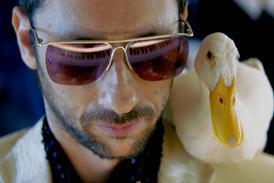Screen talks to the visual effects supervisor who worked with James Cameron on the likes of Ghosts of the Deep and Avatar.
During his keynote at 3D Stereo MEDIA, visual effects supervisor Chuck Comisky discussed the differences between creating stereoscopic 3D productions for both big budget projects and independent ones.
One of three keynote speakers at this year’s Professional Conferences, Comisky spoke on topics ranging from the need to ‘break’ 3D rules and conventions to achieve an effect to the idea of 3D being too expensive, arguing that with the right kind of planning, the uptake on budget isn’t much more than on a 2D production.
Having worked with James Cameron on the biggest box office success of all time in Avatar, Comisky praised Cameron for his work in the field looking ahead to the highly anticipated Avatar 2.
“It [Avatar 2] will break new ground; he doesn’t film something that doesn’t push the boundaries,” Comisky told Screen.
Talking of Avatar, Comisky explained how even that was a developing process. “We did roughly 40 seconds worth of polished performance capture and based on that, Fox greenlit the film… even as we went, he [Cameron] was pushing the boundaries. He didn’t just do his homework, stop and say ‘now we’re going to make a movie’. It was ‘OK, let’s make it even better’.”
One of the overriding topics of this year’s 3D Stereo MEDIA is how bad 3D is hurting the industry, yet for Comisky, it’s all about the context and the target audience, citing the success of 3D horror films. “I know what bad 3D is when it comes to doing a quality picture but then there are different genres,” noted Comisky.
He continued: “With Avatar, the goal was that the 3D not be the star of the movie. The star of the movie was the story and as a result to that, we very carefully planned it out so that people would go into a theatre and ideally, in 10-15 minutes, not think that they were in a 3D movie.”
Ultimately, 3D is something that should be involved right from the start of planning a production.
“Even if a production is going to know in advance that they’re going to convert, they should shoot that 2D picture with the 3D in mind. That’s not so complicated because a good DoP composes for depth anyway even with a 2D movie,” commented Comisky.
“If you’re going to make a photographically good movie, it’s probably going to work in 3D. If on the other hand, it’s kind of flat and the lighting and composition isn’t great, and the story isn’t great, 3D will not save a bad movie.”






![The Brightest SunScreen[Courtesy HKIFF]](https://d1nslcd7m2225b.cloudfront.net/Pictures/274x183/3/5/0/1448350_thebrightestsunscreencourtesyhkiff_312678.jpg)















No comments yet